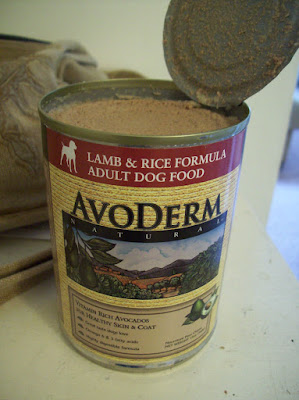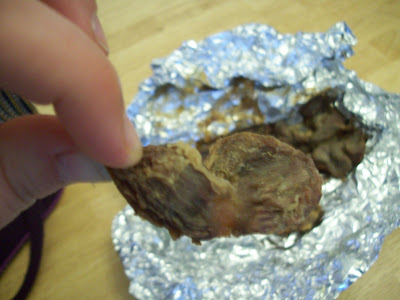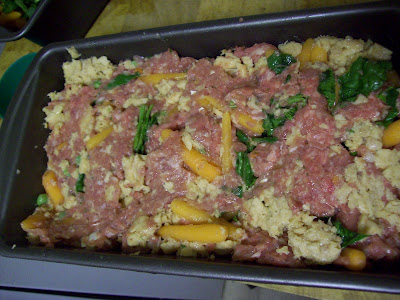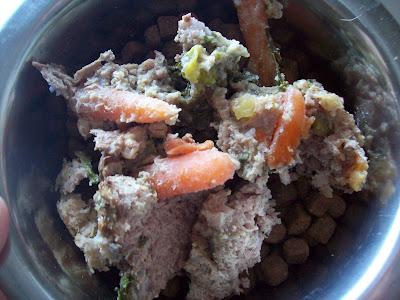Sunday, March 28, 2010
Sunday, March 21, 2010
Avoderm
Arguably, where there is a Petsmart, there is a Petco. At least in my experience.
I prefer Pet Suppies Plus either way. They typically sell Sojos, EVO, Orijen/Acana, Wellness Core, Nature's Variety, Horizon Legacy... all exceptionally great foods.
I get a few emails here and there asking for the best food you can find at Petsmart. I try to ask if one of the other two stores are local to them as well, and if the answer is "no", then there are one of two foods that in a total bind, I might feed.
- The first is Blue Buffalo Wilderness, but seeing that each variety (original, duck & salmon) has chicken in it, I wouldn't be able to feed it to one of my dogs with a proven chicken allergy.
- The second is Avoderm. The funny thing about this brand of food is that it garners either die-hard lovers, or adamant haters. Why the haters? The ASPCA warns us not to feed our dogs avocados, which is a major ingredient in Avoderm (if you couldn't tell...)
However, the company says:
So, if you believe their research, you should also believe that avocados are full of vitamins A, C, D, E, B6, and essential fatty acids for excellent skin and coat condition.
I'll admit that I was a skeptic with Avoderm, because of the toxic potential of parts of the fruit, but I decided to try one of their canned products anyway so that IF you can never, ever find any other store than Petsmart, I could safely say "try Avoderm".
I chose the Lamb & Rice canned formula because of its exclusion of chicken and beef (nice!).

Ingredients
Lamb, Lamb Broth, Ground Whole Rice, Lamb Liver, Dried Eggs, Flax Seed, Lecithin, Guar Gum, Calcium Carbonate, Kelp, Avocado Oil, Vitamin A Acetate, Vitamin D3 Supplement, Vitamin E Supplement, Vitamin B-12 Supplement, Riboflavin Supplement (Source of Vitamin B Complex), Niacin, Calcium Pantothenate, Choline Chloride, Folic Acid, Pyridoxine Hydrochloride (Source of Vitamin B6), Thiamine Mononitrate (Source of Vitamin B1), Biotin, Ascorbic Acid (Source of Vitamin C), Zinc Sulfate, Zinc Proteinate, Iron Carbonate, Manganese Sulfate, Manganese Proteinate, Copper Proteinate, Copper Carbonate, Calcium Iodate, Sodium Selenite.
Would I feed this long term? I would have to say no, honestly. Avocados contain persin, which leeches into the fruit from the pit. At toxic levels in non-humans (which may vary), symptoms include gastrointestinal irritation, vomiting, diarrhea, respiratory distress, congestion, fluid accumulation around the tissues of the heart and even death. So, you know, it's just not worth it when varieties of fish contain the same essential fatty acids and coat health properties without the persin.
In fact, I'm pretty sure I won't be trying any other Avoderm products again, because other safer foods exist out there with the same benefits. I'm not an adament hater, I just feel the risk doesn't exceed the benefit.
I prefer Pet Suppies Plus either way. They typically sell Sojos, EVO, Orijen/Acana, Wellness Core, Nature's Variety, Horizon Legacy... all exceptionally great foods.
I get a few emails here and there asking for the best food you can find at Petsmart. I try to ask if one of the other two stores are local to them as well, and if the answer is "no", then there are one of two foods that in a total bind, I might feed.
- The first is Blue Buffalo Wilderness, but seeing that each variety (original, duck & salmon) has chicken in it, I wouldn't be able to feed it to one of my dogs with a proven chicken allergy.
- The second is Avoderm. The funny thing about this brand of food is that it garners either die-hard lovers, or adamant haters. Why the haters? The ASPCA warns us not to feed our dogs avocados, which is a major ingredient in Avoderm (if you couldn't tell...)
However, the company says:
Concern has been expressed by the ASPCA about the consumption of the leaves, fruit, bark, and stems from the avocado tree, with the exception of the avocado fruit which is used for the oil and meal; none of these parts are factors in any of the AvoDerm Natural pet products formulations.
Dr. Art Craigmill, UC Davis, Professor and Extension Specialist in Environmental Toxicology has said that his studies and other research in the United States and Australia have shown that the problem of toxicity is in the leaves and the pit of the Guatemalan variety; the avocado meat of the fruit and oils have not been shown to be toxic. AvoDerm Natural pet products do not utilize any Guatemalan variety avocados, nor do we use any leaves or pits of any variety of avocados for our avocado meal and oil.
The avocado meal and oil used in the AvoDerm Natural pet products comes from the meat of the fruit and does not contain leaves, bark, skin or pit of the fruit. The oil is extracted from ripened fruit in which the meat pulp has been separated from the skin and the pit. Through a mechanical separation process the oil is extracted and filtered and placed into sealed containers. The pulp of the fruit is dried, ground, and screened before being placed into its final packaging and than shipped to our facility.
So, if you believe their research, you should also believe that avocados are full of vitamins A, C, D, E, B6, and essential fatty acids for excellent skin and coat condition.
I'll admit that I was a skeptic with Avoderm, because of the toxic potential of parts of the fruit, but I decided to try one of their canned products anyway so that IF you can never, ever find any other store than Petsmart, I could safely say "try Avoderm".
I chose the Lamb & Rice canned formula because of its exclusion of chicken and beef (nice!).

Ingredients
Lamb, Lamb Broth, Ground Whole Rice, Lamb Liver, Dried Eggs, Flax Seed, Lecithin, Guar Gum, Calcium Carbonate, Kelp, Avocado Oil, Vitamin A Acetate, Vitamin D3 Supplement, Vitamin E Supplement, Vitamin B-12 Supplement, Riboflavin Supplement (Source of Vitamin B Complex), Niacin, Calcium Pantothenate, Choline Chloride, Folic Acid, Pyridoxine Hydrochloride (Source of Vitamin B6), Thiamine Mononitrate (Source of Vitamin B1), Biotin, Ascorbic Acid (Source of Vitamin C), Zinc Sulfate, Zinc Proteinate, Iron Carbonate, Manganese Sulfate, Manganese Proteinate, Copper Proteinate, Copper Carbonate, Calcium Iodate, Sodium Selenite.
Would I feed this long term? I would have to say no, honestly. Avocados contain persin, which leeches into the fruit from the pit. At toxic levels in non-humans (which may vary), symptoms include gastrointestinal irritation, vomiting, diarrhea, respiratory distress, congestion, fluid accumulation around the tissues of the heart and even death. So, you know, it's just not worth it when varieties of fish contain the same essential fatty acids and coat health properties without the persin.
In fact, I'm pretty sure I won't be trying any other Avoderm products again, because other safer foods exist out there with the same benefits. I'm not an adament hater, I just feel the risk doesn't exceed the benefit.
Spot's Stew
Is it just me or is this canned Salmon formula from Halo's line of Spot's Stew (the cat version is grain free, and nothing in it is harmful to dogs!) getting harder and harder to find?

I think the ingredients are great, and the pup loves it and doesn't have any digestive upset from it (while I get to observe any sensitivities to cooked beef/chicken/turkey, which he doesn't seem to have).. but it is getting HARDER and HARDER to find!
Luckily a local health foods store keeps a nice stock of it, which I patronize. But I guarantee that the average dog feeder wouldn't go out of their way to find it since chains like Petco seemed to stop stocking it readily.
Anyway, this is why I like it - the ingredients - which you can see in wholesome form within the mix:
Ingredients: Salmon, chicken liver, broth, turkey, water (sufficient for processing), carrots, green beans, yellow squash, celery, zucchini, green peas, mustard greens, dried kelp, calcium citrate, flax seed meal, oats, pumpkin, sweet potato, ascorbic acid
Guaranteed Analysis:
Crude Protein - 6.4% min.
Crude Fat - 1.8% min.
Crude Fiber - 4.3% max.
Moisture - 84.0% max.

(as a kibble topper for the pup - you can see the whole vegetation)

I think the ingredients are great, and the pup loves it and doesn't have any digestive upset from it (while I get to observe any sensitivities to cooked beef/chicken/turkey, which he doesn't seem to have).. but it is getting HARDER and HARDER to find!
Luckily a local health foods store keeps a nice stock of it, which I patronize. But I guarantee that the average dog feeder wouldn't go out of their way to find it since chains like Petco seemed to stop stocking it readily.
Anyway, this is why I like it - the ingredients - which you can see in wholesome form within the mix:
Ingredients: Salmon, chicken liver, broth, turkey, water (sufficient for processing), carrots, green beans, yellow squash, celery, zucchini, green peas, mustard greens, dried kelp, calcium citrate, flax seed meal, oats, pumpkin, sweet potato, ascorbic acid
Guaranteed Analysis:
Crude Protein - 6.4% min.
Crude Fat - 1.8% min.
Crude Fiber - 4.3% max.
Moisture - 84.0% max.

(as a kibble topper for the pup - you can see the whole vegetation)
Labels:
analysis,
canned,
halo,
ingredients,
salmon,
spot's stew
Monday, March 15, 2010
Teething Help | Nylabone Edibles
Normally... I wouldn't give these bones as a treat.
Normally... I wouldn't be dealing with a wirey coated alligator.
However, I am.
There isn't a huge appeal to me about these edible bones that Nylabone makes, there is even less appeal to the non-edibles that just look like huge (phallic!) choking hazards. I guess its nice that a company is giving awareness of the need for dental health in our canine friends.
I would prefer my puppy eat raw meaty bones but with the uncertainty of which teeth are active for chewing, which are falling out, and what kind of pain he's in, I'm hesitant to give him anything raw that needs to be chewed in total before digestion.
So - in the interest of [some] safety, sanity and moments of peace that only a chew bone allows from a teething dog, I bought Healthy* Edibles Lamb & Apple for Puppies. I watch and listen while he eats this.

picking the correct size (per weight) for potential choking hazard bones should be a priority!
*In their defense, they do now claim they are gluten free formulas. Below are the ingredients.
Normally... I wouldn't be dealing with a wirey coated alligator.
However, I am.
There isn't a huge appeal to me about these edible bones that Nylabone makes, there is even less appeal to the non-edibles that just look like huge (phallic!) choking hazards. I guess its nice that a company is giving awareness of the need for dental health in our canine friends.
I would prefer my puppy eat raw meaty bones but with the uncertainty of which teeth are active for chewing, which are falling out, and what kind of pain he's in, I'm hesitant to give him anything raw that needs to be chewed in total before digestion.
So - in the interest of [some] safety, sanity and moments of peace that only a chew bone allows from a teething dog, I bought Healthy* Edibles Lamb & Apple for Puppies. I watch and listen while he eats this.

picking the correct size (per weight) for potential choking hazard bones should be a priority!
*In their defense, they do now claim they are gluten free formulas. Below are the ingredients.
Ingredients
Wheat Starch, Glycerin, Soy Meal, Cellulose, Lecithin, Potato Starch, Natural Flavor, Natural Flavor, Lamb Meal, Apple, Oat Fiber, Calcium Carbonate, Soy Flour, and Rosemary Oil Vitamins: Thiamin, Riboflavin, Pantothenic Acid, Vitamin B-6, Folic Acid, Vitamin A, Vitamin E, Biotin, Choline, Inositol and PABA Minerals: Calcium Carbonate, Ferrous Carbonate, Magnesium Oxide, Dicalcium Phosphate, Potassium Chloride, Sodium Selenite, Calcium Chloride, Zinc Oxide, Copper Oxide, Manganese Oxide and Sodium Molybdate.Analysis
Min. crude protein: 5.0%, Min. crude fat: .5%, Max. crude fiber: 8%, Max. moisture: 13% Calories per gram: 3.47Friday, March 12, 2010
puppy meatloaf version 2.0

We had a major score recently and got some local buffalo meat! The shibas got it raw, but the puppy got some mixed into a super baked meatloaf. This was a meal, not just a kibble topper.
Ingredients:
Buffalo (ground)
Turkey (ground)
Whole eggs
Spinach
Carrots
Peas
Kelp
Parsley
Served with:
Cottage cheese
Sweet potato (steamed)
Labels:
buffalo,
homecooking,
ingredients,
meatloaf,
sweet potato,
turkey
Treat | for adult dogs only!
I say for adult's only because these come out thick and hard, and require adult teeth to chew them down.
Chicken Gizzards are a great muscle meat when served raw. Check out nutritiondata.com for the nutrient breakdown.
I thought it would be a great treat for the puppy (who is teething) but he couldn't get through the raw form. It is really elastic and chewy, and he had a tough time.
So, I sliced them in half, put them on a tin covered baking tray on broil and let them sizzle for about 45 minutes.
They came out looking a bit like chewy beef jerky:

My adult dogs LOVE them, but still the puppy had a tough time with them! He did manage to "num" it down a bit, just chewing it and chewing it. I think it did the trick and he ended up eating two in one sitting.

In retrospect, I think sticking with the raw version would have been easier on us all!
Chicken Gizzards are a great muscle meat when served raw. Check out nutritiondata.com for the nutrient breakdown.
I thought it would be a great treat for the puppy (who is teething) but he couldn't get through the raw form. It is really elastic and chewy, and he had a tough time.
So, I sliced them in half, put them on a tin covered baking tray on broil and let them sizzle for about 45 minutes.
They came out looking a bit like chewy beef jerky:

My adult dogs LOVE them, but still the puppy had a tough time with them! He did manage to "num" it down a bit, just chewing it and chewing it. I think it did the trick and he ended up eating two in one sitting.

In retrospect, I think sticking with the raw version would have been easier on us all!
Monday, March 8, 2010
Weight
Taken from a post by K9 Solutions Dog Training (thanks!) called Killing them with Kindness
..This chart which might make it more helpful for people to understand how a little bit of weight can be more of a problem than they realize.
In toy breeds 1 pound of extra weight = 31 pounds on a human body
+2 lbs = 63
+3lbs = 94
In small breeds 2 lbs of extra weight = 13 lbs on a human body
+4 lbs = 26 lbs
+6 lbs = 40 lbs
In medium breeds 4 lbs of extra weight = 17 lbs on a human body
+6 lbs = 25 lbs
+ 8 lbs = 33 lbs
In large breeds 6 lbs of extra weight = 11 lbs on a human body
+8 = 14
+10 = 18 lbs
In giant breeds we are equal 10lbs = 10 lbs and so on.
* * * * * * * *
Here is a chart that lets you see how to assess your dogs body condition:
http://www.placervillevet.com/canine%20body%20condition.htm
..This chart which might make it more helpful for people to understand how a little bit of weight can be more of a problem than they realize.
In toy breeds 1 pound of extra weight = 31 pounds on a human body
+2 lbs = 63
+3lbs = 94
In small breeds 2 lbs of extra weight = 13 lbs on a human body
+4 lbs = 26 lbs
+6 lbs = 40 lbs
In medium breeds 4 lbs of extra weight = 17 lbs on a human body
+6 lbs = 25 lbs
+ 8 lbs = 33 lbs
In large breeds 6 lbs of extra weight = 11 lbs on a human body
+8 = 14
+10 = 18 lbs
In giant breeds we are equal 10lbs = 10 lbs and so on.
* * * * * * * *
Here is a chart that lets you see how to assess your dogs body condition:
http://www.placervillevet.com/canine%20body%20condition.htm
Friday, March 5, 2010
ASPCA Report | Three Dogs Die from Meatball Poisoning
Spokane County Regional Animal Protection Service (SCRAPS), an ASPCA community partner, has launched an investigation into the recent deaths of three dogs at two different locations in the South Hill neighborhood of Spokane, WA.
On February 19, a woman reported to SCRAPS that she let her dogs outside at approximately 6:00 A.M., and when she went to feed her horses, saw one of the dogs eating something off the ground. She called her dog away from what was later identified as meatballs. Approximately 30 minutes later, the dog started having convulsions and was taken to an emergency clinic, where he died. Two other dogs were reported dead by another pet parent in the South Hill neighborhood on the same day... click for the whole story
On February 19, a woman reported to SCRAPS that she let her dogs outside at approximately 6:00 A.M., and when she went to feed her horses, saw one of the dogs eating something off the ground. She called her dog away from what was later identified as meatballs. Approximately 30 minutes later, the dog started having convulsions and was taken to an emergency clinic, where he died. Two other dogs were reported dead by another pet parent in the South Hill neighborhood on the same day... click for the whole story
Wednesday, March 3, 2010
feelin' feisty | risks of raw
The following is from a 'tidy' little blurb about how feeding raw meat to your dog is going to cause you, well, death. Or at least a nasty case of salmonella.
Let's explore the blurb:
Can I just say that handling an egg for yourself to fry can also pose a risk of salmonella?
This is my favorite line, like ever, "homemade cooked diets also made the list could be explained by the fact that in order to make such a diet, owners still need to start with the raw ingredients". Because commercial products (that they are so very much for, I gather?) are never ever made with fresh, raw ingredients? Science Diet gets their chicken ingredient from already cooked chicken that was never, ever raw?
And... isn't this how we prepare our own food? Shouldn't there be a 1-4% increase in Salmonella in my own stool samples?
Can I also just say that perhaps all these homes visited were never taught how to wash their hands? Never taught how to store, handle and prepare raw meat? If feeding myself comes at somewhat of a "no brainer", feeding my dog should also.
Ever eat sashimi? Specifically chicken sashimi dipped in raw egg? It is fabulously tasty. Risky? Sure, but most Japanese cuisine (that I've had the good fortune to consume) that is served raw is handled with the utmost care and selected from only the best of sources. I aim to do the same with myself and dogs. Choose meat intended for food with the utmost care and selected from the best source.
Or maybe its luck that I've been preparing and eating flesh & eggs & spinach & tomatoes for decades, and feeding my dogs raw for over two years... and none of us have contracted any parasites or bacteria.
I want to explore how one gets infected with Salmonella.
From the Center for Disease Control:
How do people catch Salmonella?
Also, the Risks of Raw study points at raw-fed dogs shedding Salmonella. Not infections, not infections of family members, but just that it is present in their feces. As the public is not prone to rub dog feces in their face, the risk of infection should be low. Is there proof otherwise? Not in this study.
Dogs also shed E.coli! Shouldn't we be having a state of emergency over E.coli as well?
Shouldn't we never own reptiles? Never eat peanut butter? Spinach? Tomatoes?
The unbelievably biased point of view is most evident in their final paragraph.
Well-established? When? By whom? How much risk, exactly, and of what?
Now that my feisty has run out... I'm just trying to see if from their perspective... do you think its also a case in knowing TOO much? Being TOO aware? Never doing what could be biologically the best thing ever for your dog (feeding raw) because you are too hyper aware of the POTENTIAL risks?
Maybe a bit of ignorance is truly bliss... I don't worry as much about the risks of parasites, bacteria and zoonosis thereof because I'm confident in how I safely/smartly handle, store, prepare and feed the raw food.
Man, I wish I worked for Mythbusters!
Let's explore the blurb:
Risks of Raw
The study looked at 138 dogs from 84 households in Ontario. One-quarter of households (21/84, 25%) had at least one dog (32/138, 23.2%) that was shedding Salmonella at one time, which is considerably higher than the 1-4% of pet dogs that are typically expected to be shedding this zoonotic pathogen.
1. Consuming a commercial or homemade raw diet, a homemade cooked diet, or raw meat and eggs, increases a pet dog’s risk of carrying Salmonella.
Raw is raw, and by now we're hoping that people are getting the message that raw is contaminated, whether we're talking about a commercial or homemade raw diet, or feeding any raw animal products (e.g. meat, eggs). The fact that homemade cooked diets also made the list could be explained by the fact that in order to make such a diet, owners still need to start with the raw ingredients. Handling and cooking raw meat and animal products for your pet should be done with the same precautions as handling and cooking raw meat for yourself or your family. If these homemade diets were not cooked as thoroughly as they should have been, or if there was contamination of the dog's dishes with raw product, that could explain the association with Salmonella shedding. Although traditional commercial diets can also be contaminated with pathogens (usually after processing), the risk with these is much lower.
Can I just say that handling an egg for yourself to fry can also pose a risk of salmonella?
This is my favorite line, like ever, "homemade cooked diets also made the list could be explained by the fact that in order to make such a diet, owners still need to start with the raw ingredients". Because commercial products (that they are so very much for, I gather?) are never ever made with fresh, raw ingredients? Science Diet gets their chicken ingredient from already cooked chicken that was never, ever raw?
And... isn't this how we prepare our own food? Shouldn't there be a 1-4% increase in Salmonella in my own stool samples?
Can I also just say that perhaps all these homes visited were never taught how to wash their hands? Never taught how to store, handle and prepare raw meat? If feeding myself comes at somewhat of a "no brainer", feeding my dog should also.
Ever eat sashimi? Specifically chicken sashimi dipped in raw egg? It is fabulously tasty. Risky? Sure, but most Japanese cuisine (that I've had the good fortune to consume) that is served raw is handled with the utmost care and selected from only the best of sources. I aim to do the same with myself and dogs. Choose meat intended for food with the utmost care and selected from the best source.
Or maybe its luck that I've been preparing and eating flesh & eggs & spinach & tomatoes for decades, and feeding my dogs raw for over two years... and none of us have contracted any parasites or bacteria.
2. Testing multiple consecutive whole fecal samples greatly improves Salmonella recovery in dogs.FIVE daily samples. FIVE. I can't imagine any raw fed dog providing a fecal sample FIVE times a day. I'm lucky if I get ONE a day (because of how wonderfully a raw diet is digested).
This is no great surprise either. Dogs (and many other species) shed Salmonella intermittently, so not every fecal sample from a Salmonella-positive dog is going to yield Salmonella on culture. The authors tested five daily fecal samples from each dog. Based on this study, the sensitivity of testing a single fecal sample in a dog (i.e. the likelihood that a Salmonella-positive dog will test positive on one fecal sample) was only 35.5%. That means almost two-thirds of positive dogs will be missed if they're only tested once. The take-home message on this point is that in order to find Salmonella in a healthy pet dog, multiple samples should be tested.
I want to explore how one gets infected with Salmonella.
From the Center for Disease Control:
How do people catch Salmonella?
Salmonella live in the intestinal tracts of humans and other animals, including birds. Salmonella are usually transmitted to humans by eating foods contaminated with animal feces. Contaminated foods usually look and smell normal. Contaminated foods are often of animal origin, such as beef, poultry, milk, or eggs, but any food, including vegetables, may become contaminated. Thorough cooking kills Salmonella. Food may also become contaminated by the hands of an infected food handler who did not wash hands with soap after using the bathroom.
Salmonella may also be found in the feces of some pets, especially those with diarrhea, and people can become infected if they do not wash their hands after contact with pets or pet feces. Reptiles, such as turtles, lizards, and snakes, are particularly likely to harbor Salmonella. Many chicks and young birds carry Salmonella in their feces. People should always wash their hands immediately after handling a reptile or bird, even if the animal is healthy. Adults should also assure that children wash their hands after handling a reptile or bird, or after touching its environment.
Also, the Risks of Raw study points at raw-fed dogs shedding Salmonella. Not infections, not infections of family members, but just that it is present in their feces. As the public is not prone to rub dog feces in their face, the risk of infection should be low. Is there proof otherwise? Not in this study.
Dogs also shed E.coli! Shouldn't we be having a state of emergency over E.coli as well?
Shouldn't we never own reptiles? Never eat peanut butter? Spinach? Tomatoes?
3. Having multiple dogs in a household, using probiotics and contact with livestock are important potential risk factors that need to be investigated further.
These were factors that were flagged by the authors for future investigation, because at first they seemed to be associated with Salmonella shedding in the dogs, but when the feeding of raw diets was taken into account the associations were no longer significant. A larger study, or one using a different design, will be needed to help tease apart the potential effects of these factors from feeding practices.
The bottom line: Feeding raw is risky business. Some people swear by the benefits of raw diets, but the objective evidence is lacking. There is clear evidence of the risks. In my mind, the potential up-side simply cannot outweigh the well-established down-side of feeding raw diets to pets.
The unbelievably biased point of view is most evident in their final paragraph.
Well-established? When? By whom? How much risk, exactly, and of what?
Now that my feisty has run out... I'm just trying to see if from their perspective... do you think its also a case in knowing TOO much? Being TOO aware? Never doing what could be biologically the best thing ever for your dog (feeding raw) because you are too hyper aware of the POTENTIAL risks?
Maybe a bit of ignorance is truly bliss... I don't worry as much about the risks of parasites, bacteria and zoonosis thereof because I'm confident in how I safely/smartly handle, store, prepare and feed the raw food.
Man, I wish I worked for Mythbusters!
Tuesday, March 2, 2010
puppy meatloaf
I've been trying something new with Buckley, who doesn't seem to have any sensitivities to food yet.
Raw is the ultimate diet for many educated dog owners/feeders... and it should be. It is the original canine diet.
However, for one reason or another, sometimes the owner or the dog just can't do it all the time.
For me, the puppy and his teething was a hindrance for beginning raw (sans grinder). Well, I got my grinder and I find there is quite a bit to be desired with ground bones. For me (and me alone) I don't feel safe feeding them in their raw, ground form. I have been giving Buckley raw chicken bones, whole, and he's done well with them.
I use the grinder now to make meat loaf. Our first batch was a hit!

raw, not yet cooked.
Ingredients:
Ground sirloin, approx 90% lean + few oz of beef liver (also ground)
Salmon
Whole Eggs, 2, (with ground egg shell)
Carrots
Spinach
Peas
Ground Apples (without skin or seeds)
Kelp, powder
Parsley, fresh
Alfalfa, powder
Garlic, fresh minced
To measure - I used a ratio of about 60 meat/protein : 40 vegetation. That's it.

baked 1 hour, chilled, and served as a kibble topper.
* * * * * * * * * * * * *
Analyzing the recipe on nutritiondata.com, per ounce:
Fat - 2g
Protein - 4.4g
Carbs - 1g (dietary fiber - 0.3g)
B12 - 0.6mcg
Calcium - 28.1mg
Phosphorus - 55mg
Omega 3 - 183mg
Omega 6 - 85.4mg
Water - 20.3g
Raw is the ultimate diet for many educated dog owners/feeders... and it should be. It is the original canine diet.
However, for one reason or another, sometimes the owner or the dog just can't do it all the time.
For me, the puppy and his teething was a hindrance for beginning raw (sans grinder). Well, I got my grinder and I find there is quite a bit to be desired with ground bones. For me (and me alone) I don't feel safe feeding them in their raw, ground form. I have been giving Buckley raw chicken bones, whole, and he's done well with them.
I use the grinder now to make meat loaf. Our first batch was a hit!

raw, not yet cooked.
Ingredients:
Ground sirloin, approx 90% lean + few oz of beef liver (also ground)
Salmon
Whole Eggs, 2, (with ground egg shell)
Carrots
Spinach
Peas
Ground Apples (without skin or seeds)
Kelp, powder
Parsley, fresh
Alfalfa, powder
Garlic, fresh minced
To measure - I used a ratio of about 60 meat/protein : 40 vegetation. That's it.

baked 1 hour, chilled, and served as a kibble topper.
* * * * * * * * * * * * *
Analyzing the recipe on nutritiondata.com, per ounce:
Fat - 2g
Protein - 4.4g
Carbs - 1g (dietary fiber - 0.3g)
B12 - 0.6mcg
Calcium - 28.1mg
Phosphorus - 55mg
Omega 3 - 183mg
Omega 6 - 85.4mg
Water - 20.3g
Labels:
analysis,
beef,
homecooking,
ingredients,
meatloaf,
salmon
raw feeding is not a fad.
Health consciousness is not a fad. It is a way of living life!
Visit Jack LaLanne's website for more videos, blog, etc.
Subscribe to:
Posts (Atom)


